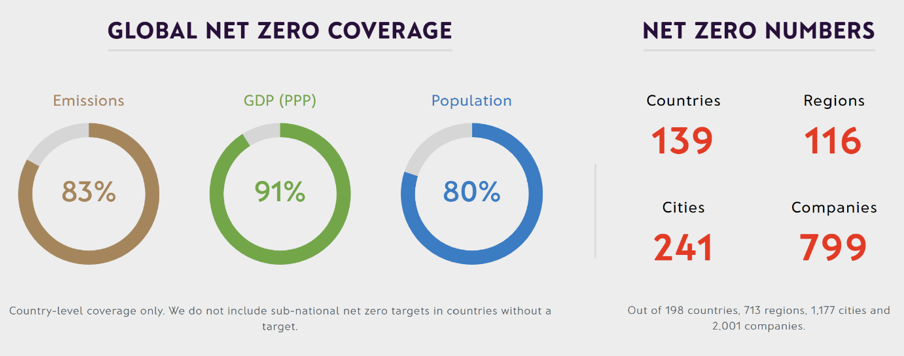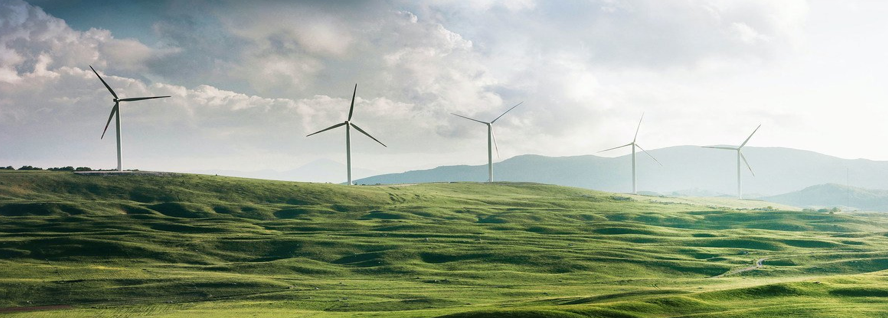Governments and companies are increasingly committing to address their emissions. The physical manifestations of climate change and their socioeconomic impacts are becoming more and more visible. With the last decade being the warmest on record, experts warn that if we do not reduce our current emission levels, we are facing an expected temperature increase of 3 to 5 ˚C by the end of the century. To avoid a climate crisis, drastic reduction on emissions is necessary.
Net-zero pledges are used more and more to communicate the commitment to climate action and to reach the goal of the Paris Agreement of limiting the warming of the earth to 1.5˚C. Net zero describes a state in which human emissions and their removal will be in sum zero. This can be achieved by a reduction of emissions and by absorbing any residual emissions from the atmosphere.
Net-zero coverage
Currently 83% of global emissions are covered by net-zero pledges. The European Union plans to reach the goal by 2050 which is consistent with the ambitions of the United Nations. A fifth of the companies on the Forbes list, representing $14 trillion in sales, have also committed themselves. Big companies such as Apple and Microsoft pledge to reach net-zero by 2030.

How to achieve net-zero
Two steps are necessary to achieve net-zero: Firstly, the reduction of emissions and secondly, the removal of the residual emissions which are hard to eliminate, the so called “hard-to-abate emissions”. This removal is often called “offsetting” and is achieved by polluters buying “carbon offsets”. They represent a reduction or avoided emission somewhere else.
Technology to move towards lower emissions already exists. A move towards renewable energy can slash emissions. Renewable energy is not only cleaner but in the long run often cheaper. Harmful emissions caused by agriculture can be avoided by moving towards a more plant-based diet. We also have solutions to remove carbon dioxide from the atmosphere. Nature has been doing that for thousands of years. Carbon is absorbed and stored in trees, the soil, mangroves and even seaweed. Now our focus is on protecting those carbon sinks and creating new ones. New technology options have also been developed in recent years. Technologies such as “Direct Air Capture” which filters carbon out of the air with the ability to store it for thousands of years as stone in the ground.

These pledges therefore do not mean that companies and countries will not emit any pollutants anymore as there is the possibility to “offset” the hard-to-abate emissions. Ideally, the emissions we need to remove from the atmosphere will be lowered over time as we more and more reduce emissions in the first place.
The problem with net-zero pledges
The issue with pledges is that they are a promise, not a plan or a legally binding commitment. Concerns are being raised if companies pledge commitment to seem more environmentally friendly than they are. Research found that many pledges lack the ambition to achieve the goal of limiting global warming to 1.5 ˚C. Yet, the commitments have advanced in the last years: sixty percent of entities with a net-zero pledge have interim goals and reporting mechanisms in place. But there is a huge gap in quality of the commitments. Only twenty percent meet the minimum criteria for robustness developed by the United Nations.

Another big concern is the removal of emissions from the atmosphere, the “offsetting”. Experts are concerned that many polluters will rely too heavily on buying “offsets”, without taking the necessary steps to reduce their own emissions first. Additionally, removal projects often lack quality and are developed in the global south, which historically has been emitting less than the rest of the world. This creates ethical concerns as this can be perceived as shift of responsibility towards those most affected by climate change and the least responsible. While the development of effective carbon storage such as forests can take decades or even centuries to grow, the removal achieved in these projects is often short-term. A tree, for example, will live only for a limited time and is subject to unpredictable damage such as wildfires, after which the carbon stored could be released again. To truly stabilize the climate, we need permanent carbon storages, for which few projects exist today.
A credible pledge can be identified by an existing plan, near-term goals to keep the action going, (future) annual progress reports, plans on usage of “carbon offsets”, and clarity on which emissions in the value chain are included in the pledge.
Room for improvement
Despite all the issues that come with most current net-zero pledges, they remain essential as they represent ambition towards climate action. The global momentum of increased pledges in recent years opens a discussion which has to be followed by robust and swift actions. Pledging is the first step, now companies and governments must let their actions speak.
References:
Black, R., Cullen, K., Fay, B., Hale, T., Lang, J., Mahmood, S., Smith, S.M. (2021). Taking Stock: A global assessment of net zero targets. Energy & Climate Intelligence Unit and Oxford Net Zero. Available at: https://eciu.net/analysis/reports/2021/taking-stock-assessment-net-zero-targets
Cairns E. (2020). Net zero – idle promises? Available at: https://www.abrdn.com/en-gb/intermediary/insights-thinking-aloud/article-page/net-zero-idle-promises
Lindwall, C. (2022). The Promise and Pitfalls of Net-Zero Pledges. Available at: https://www.nrdc.org/stories/promise-and-pitfalls-net-zero-pledges
Mendiluce, M. (2021). Your Company Pledged to Reduce Its Carbon Footprint. Now What? Available at: https://hbr.org/2021/06/your-company-pledged-to-reduce-its-carbon-footprint-now-what
Net Zero Tracker (2022). Available at: zerotracker.net
Shetty, D. (2021). A Fifth Of World’s Largest Companies Committed To Net Zero Target. Available at: https://www.forbes.com/sites/dishashetty/2021/03/24/a-fifth-of-worlds-largest-companies-committed-to-net-zero-target/?sh=4c0d06fe662f
United Nations (2020). The race to zero emissions, and why the world depends on it. Available at: https://news.un.org/en/story/2020/12/1078612
United Nations (n.d.). Net-zero pledges grow; ambition falls short. Available at: https://www.un.org/en/climatechange/net-zero-pledges-grow

